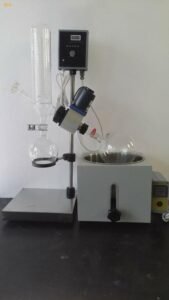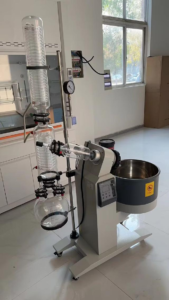In the field of organic chemistry, the rotary evaporator is an essential tool for separating solvents from chemical mixtures. Its ability to provide precise control over temperature, vacuum, and rotation speed makes it indispensable for laboratories and industrial applications. The Manual Rotary Evaporator for Organic Chemistry by Equilrxnlab is a powerful and versatile device designed to meet the needs of researchers working with various organic solvents and compounds.
This article delves into the features, benefits, and applications of the Manual Rotary Evaporator for Organic Chemistry, demonstrating how it enhances research productivity and efficiency.
What is a Manual Rotary Evaporator?
A rotary evaporator, commonly known as a rotovap, is a laboratory instrument used for the efficient removal of solvents through evaporation. It uses a rotating flask, which increases the surface area of the liquid, combined with a vacuum to lower the solvent’s boiling point. The Manual Rotary Evaporator for Organic Chemistry by Equilrxnlab provides an excellent combination of manual height adjustment, customizable temperature settings, and high-capacity functionality, making it ideal for various chemical and industrial applications.
This model is particularly favored for smaller-scale operations or laboratories where hands-on control is necessary. By manually adjusting the height with the handwheel lift, researchers can ensure optimal evaporation conditions for each specific solvent.
Key Features of the Manual Rotary Evaporator for Organic Chemistry
The Manual Rotary Evaporator for Organic Chemistry boasts a range of features that make it ideal for laboratory and industrial-scale solvent evaporation:
- Vacuum Pressure: 0.098 Mpa: This rotary evaporator operates with a vacuum pressure of 0.098 Mpa, which allows for efficient evaporation of solvents while preserving sensitive compounds by lowering the boiling point.
- Rotary Flask Capacity: 20L: With a rotary flask capacity of 20L, this device can handle relatively large volumes of solvents, making it ideal for medium to high-scale operations.
- Collection Flask Capacity: 10L: The 10L collection flask allows for efficient collection and condensation of solvents, ensuring that no valuable solvent is wasted.
- Rotational Speed: 0-120 rpm: The adjustable rotational speed of 0-120 rpm enables users to customize the evaporation process, optimizing solvent recovery and preventing overheating of heat-sensitive substances.
- Cooling Area: 0.95㎡ (0.46 + 0.49): The large cooling area ensures efficient condensation, maximizing solvent recovery during the evaporation process.
- Rotary Motor Power: 120W: A 120W motor powers the rotation of the flask, providing reliable performance and ensuring smooth and consistent operation during the evaporation process.
- Heating Power: 3KW: With a 3KW heating power, the rotary evaporator provides rapid and efficient heating of the solvent, speeding up the evaporation process and increasing productivity.
- Bath Capacity: 40L: The large bath capacity of 40L ensures that there is sufficient space for solvent heating, providing uniform and controlled temperature distribution.
- Temperature Range: Room Temperature – 99°C (customizable): The temperature range is highly versatile, allowing the user to select the ideal temperature for the specific solvent being evaporated. This flexibility is crucial for working with different chemicals and materials.
- Temperature Accuracy: ±1°C: The rotary evaporator provides accurate temperature control with a tolerance of just ±1°C, ensuring consistency in the evaporation process.
- Lift System: Handwheel lift for precise manual height adjustment: The handwheel lift system offers precise control over the height of the rotary flask, allowing users to adjust the distance between the bath and the flask for optimal evaporation conditions.
Applications of the Manual Rotary Evaporator for Organic Chemistry
The Manual Rotary Evaporator for Organic Chemistry from Equilrxnlab is highly versatile and can be used in various applications within organic chemistry and beyond. Some of the key applications include:
1. Chemical Synthesis
In chemical synthesis, rotary evaporators are commonly used to remove solvents after chemical reactions, allowing researchers to concentrate products or purify compounds. The Manual Rotary Evaporator for Organic Chemistry provides the necessary control over temperature and rotational speed, making it ideal for organic synthesis processes.
2. Pharmaceutical Industry
In pharmaceutical production, rotary evaporators are used to evaporate solvents from active pharmaceutical ingredients (APIs), leaving behind the concentrated drug compounds. This device is particularly useful for handling heat-sensitive pharmaceuticals, as it provides precise temperature control and prevents the degradation of valuable substances.
3. Environmental Chemistry
Rotary evaporators are frequently used in environmental chemistry to concentrate and purify samples from soil, water, and air. The Manual Rotary Evaporator for Organic Chemistry is perfect for environmental testing, as it offers excellent solvent recovery and ensures that sample integrity is maintained during the evaporation process.
4. Food and Beverage Industry
In the food and beverage industry, rotary evaporators are employed to extract flavors, fragrances, and essential oils from natural products. The adjustable temperature settings of the Manual Rotary Evaporator for Organic Chemistry allow for the gentle removal of solvents, preserving the delicate aroma and taste of essential oils.
5. Nanotechnology and Material Science
In nanotechnology and material science, rotary evaporators are used to remove solvents from nanomaterial formulations and to purify advanced materials. The Manual Rotary Evaporator for Organic Chemistry is ideal for these applications, as its high capacity and precise control allow for the gentle evaporation of solvents from complex mixtures.
Benefits of Using the Manual Rotary Evaporator for Organic Chemistry
The Manual Rotary Evaporator for Organic Chemistry offers several advantages that make it an ideal choice for laboratories and industries requiring reliable solvent evaporation. Below are some of the primary benefits of using this device:
- Manual Lift for Precision: The handwheel lift system provides precise control over the height of the flask, allowing users to adjust the evaporation process for optimal results.
- High Capacity: With a 20L rotary flask and a 10L collection flask, this rotary evaporator is capable of handling larger volumes, making it suitable for industrial-scale operations.
- Flexible Temperature Control: The customizable temperature range allows for the evaporation of various solvents, with accurate temperature control to prevent overheating of sensitive compounds.
- Efficient Solvent Recovery: The large cooling area and high-powered motor ensure efficient solvent recovery, which is crucial for saving both time and resources.
- Compact and Durable Design: Despite its high capacity, the Manual Rotary Evaporator for Organic Chemistry features a compact design that is durable and easy to maintain, ensuring long-term reliability and performance.
How to Operate the Manual Rotary Evaporator for Organic Chemistry
Operating the Manual Rotary Evaporator for Organic Chemistry is straightforward, thanks to its user-friendly design. Below are the basic steps to operate the device:
- Set Up the Device: Connect the vacuum, heating bath, and rotary flask. Ensure that all components are securely attached and ready for use.
- Prepare the Sample: Fill the rotary flask with the solvent to be evaporated. Make sure not to overfill the flask, leaving enough space for the liquid to rotate.
- Adjust the Settings: Set the desired temperature, rotational speed, and vacuum pressure. Make sure the temperature is appropriate for the solvent being used.
- Begin Evaporation: Start the vacuum pump and heating system, and begin rotating the flask. Monitor the process to ensure the evaporation is occurring smoothly.
- Collect the Solvent: Once the evaporation is complete, the solvent will condense in the collection flask. Remove the flask and complete the process.
- Clean the Device: After use, clean the rotary evaporator and all components to ensure its longevity and efficient operation for future use.
Explore More About the Manual Rotary Evaporator for Organic Chemistry
For more details on the Manual Rotary Evaporator for Organic Chemistry and to explore its complete range of features and specifications, visit the product page. For inquiries or additional support, please feel free to contact us.
Social Media Links:
- YouTube: Equilrxnlab YouTube Channel
- Instagram: Equilrxnlab Instagram
- Facebook: Equilrxnlab Facebook
Discover our full product catalog: Product Catalog.




